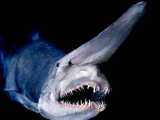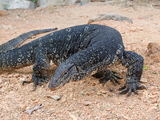Carnivores, meaning "meat eater" (Latin, "caro", genitive "carnis", meaning "meat" or "flesh" and "vorare" meaning "to devour"), are animals whose food and energy requirements derive solely from animal tissue or meat, whether through hunting or scavenging. Animals that depend solely on animal flesh for their nutrient requirements are called obligate carnivores while those that also consume non-animal food are called facultative carnivores. Omnivores also consume both animal and non-animal food, and, apart from the more general definition, there is no clearly defined ratio of plant to animal material that would distinguish a facultative carnivore from an omnivore. A carnivore at the top of the food chain, not preyed upon by other animals, is termed an apex predator.
"Carnivore" also may refer to the mammalian order Carnivora, but this is somewhat misleading: many, but not all, Carnivora are meat eaters, and even fewer are true obligate carnivores (see below). For example, while the Arctic polar bear eats meat almost exclusively (more than 90% of its diet is meat), most species of bears are omnivorous, and the giant panda is exclusively herbivorous. There are also many carnivorous species that are not members of Carnivora. The correct term for mammals in this group is "carnivoran". Besides, some mammals, especially the cetaceans, are highly carnivorous yet are not true Carnivorans.
Carnivores are sometimes characterized by their type of prey. For example, animals that eat mainly insects and similar invertebrates are called insectivores, while those that eat mainly fish are called piscivores. The 1st tetrapods, or land-dwelling vertebrates, were piscivorous amphibians known as labyrinthodonts. They gave rise to insectivorous vertebrates and, later, to predators of other tetrapods.
Outside the animal kingdom, there are several genera containing carnivorous plants (predominantly insectivores) and several phyla containing carnivorous fungi (preying mostly on microscopic invertebrates such as nematodes, amoebae and springtails).
Carnivores may alternatively be classified according to the percentage of meat in their diet. The diet of a hypercarnivore consists of more than 70% meat, that of a mesocarnivore 30–70%, and that of a hypocarnivore less than 30%, with the balance consisting of non-animal foods such as fruits, other plant material, or fungi.
This category is for animals that are carnivores in at least one stage of their life.
-

Salmon Shark -

New Guinea Bockadam -
Asian Water Monitor -
Green Anaconda -

Purple Heron -

Goblin Shark -
Gray Wolf -
Jaguar
All items (217)
- Aardwolf
- African Leopard
- African Rock Python
- African Softshell Turtle
- African Wild Dog
- African Wildcat
- Alligator Gar
- American Alligator
- American Badger
- American Bullfrog
- American Crocodile
- American Ermine
- American Golden Silk Orbweaver
- American Goshawk
- American Kestrel
- Antarctic Petrel
- Antarctic Silverfish
- Arctic Tern
- Arctic Wolf
- Arizona Bark Scorpion
- Asian Water Monitor
- Atka Mackerel
- Atlantic Blue Marlin
- Atlantic Cod
- Atlantic Flying Fish
- Atlantic Goliath Grouper
- Atlantic Puffin
- Atlantic Sea Nettle
- Eastern Chanting Goshawk
- Eastern Diamondback Rattlesnake
- Eastern Kingsnake
- Eastern Screech Owl
- Egyptian Cobra
- Electric Eel
- Elf Owl
- Emperor Penguin
- Ethiopian Wolf
- Eurasian Eagle-owl
- Eurasian Lynx
- European Garden Spider
- European Hedgehog
- European Mantis
- European Mole
- European Polecat
- Eyed Flounder
- Eyeless Shrimp
-
Category:Gars
- Giant Isopod
- Giant Oceanic Manta Ray
- Giant Otter
- Giant Pacific Octopus
- Giant Squid
- Gila Monster
- Globe Skimmer
- Goblin Shark
- Golden Eagle
- Goldenrod Crab Spider
- Goliath Birdeater
- Gray Wolf
- Great Blue Heron
- Great Emerald Pondhawk
- Great Grey Owl
- Great Hammerhead
- Great Horned Owl
- Great White Shark
- Green Anaconda
- Green Heron
- Green Moray
- Grizzly Bear
- Grooved Brain Coral
- Ground Pangolin
- Salmon Shark
-
Sand Cat
- Sand Perch
- Sea Otter
- Secretarybird
- Serval
- Shortfin Mako Shark
- Siberian Tiger
- Smallmouth Bass
-
Category:Snakes
- Snow Leopard
- Snowy Owl
- Sonoran Collared Lizard
-
Spectacled Caiman
- Spectacled Cobra
- Sperm Whale
- Spotted Eagle-owl
- Spotted Hyena
- Staghorn Coral
- Star-nosed Mole
- Starfish
- Steller Sea Lion
- Sunda Clouded Leopard



























































































































































































